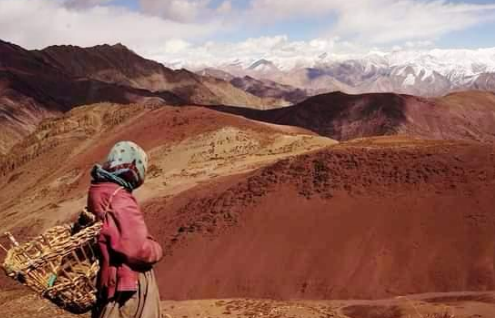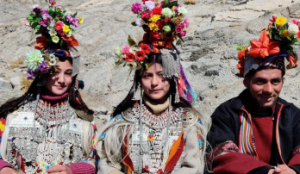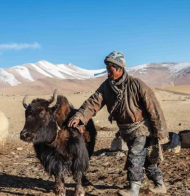सीएसआईआर - कोशिकीय एवं आणविक जीवविज्ञान केन्द्र
वैज्ञानिक तथा औद्योगिक अनुसंधान परिषद
भारत का नवप्रवर्तन इंजन
Date : अगस्त 30, 2024

Hyderabad, 19th Jan, 2024: Ladakh is an high-altitude region, characterised by an alternating valley-range configuration with complex terrain and micro-climates operating over the terrainfacets and snowfall. The altitude varies from about 3000 m in Kargil to more than 8000 m in Karakoram. It lies at a strategic location between the Indus River valley and the Hindu Khush Mountains, which makes this “Land of high passes” one of the major routes for movement of people. Through the years, the region has faced multi-layered cultural movements, genetic assimilation and demographic changes. The initial settlement in the years goes back to the early Neolithic age (12000 years ago) and still continues despite its harsh, unhospitable and cold climate. The recent study by Dr Kumarasamy Thangaraj, JC Bose Fellow, CSIR-Centre for Cellular and Molecular Biology (CCMB); and Dr Niraj Rai, Senior Scientist, DST-Birbal Sahni Institute of Palaeosciences (BSIP), Lucknow unravels the genetic history of the Ladakhi population.
in this first high-throughput mitochondrial DNA study, the researchers have analysed DNA of 108 individuals from three major communities (Brokpa, Changpa and Monpa) of Ladakh. They compared the DNA sequence of Ladakh populations with modern and ancient DNA sequences from South Asia, East Asia, Tibet and West Eurasia, and corroborated their findings with archaeological and historical records. This study has helped them to fill the gap in the history of demographic changes and population transformations of Ladakh region since Bronze age (3000 years ago) and how they relate with contemporary Eurasians. This finding has been published recently in the journal Mitochondrion.
Dr Kumarasamy Thangaraj, senior author of the study said, “The maternal genetic lineages of the Brokpa, Changpa and Monpa populations of Ladakh are related South Asian, East Asian, and Tibetan – specific maternal lineages
This study found that Changpa and Monpa share common maternal genetic ancestor, while Brokpa is distinct and suffered population decline about 1000-2000 years ago. They further found that Changpa and Monpa showed genetic affinity with Tibeto-Burman speakers.
“This study strongly suggests that among the extant populations Brokpa are the most ancient settlers of the region, with very deep mitochondrial lineage going back to Neolithic period.”, said Dr Niraj Rai, co- corresponding author of the paper
“These findings conclusively indicate the demographic changes and population transitions in Ladakh region in India associated with the migrations from East Asia, Tibet, South Asia and more recently from west Eurasia.” Said Prof Mahesh G. Thakkar, Director, Birbal Sahni Institute of Palaeosciences, Lucknow.
Dr Vinay K. Nandicoori, Director, CSIR-Centre for Cellular and Molecular Biology, Hyderabad, explained that this study further confirms and supports the movement of people through the Trans Himalayan corridor and the silk route.
The other institutes involved in this study are Archaeological Survey of India, Dehradun, Uttarakhand, Archaeological Survey of India, Mini Circle Leh, UT Ladakh, Panjab University, Chandigarh and AcSIR, Ghaziabad.
 Brokpas
Brokpas

Changpas
 Advertisement no 07/10 for the post Junior Scientist.
Advertisement no 07/10 for the post Junior Scientist.
 List of shortlisted candidates for the temporary positions against CCMB Web Notif.No.0724/B- [26-08-2024]
List of shortlisted candidates for the temporary positions against CCMB Web Notif.No.0724/B- [26-08-2024]
 Result of selected candidates for the temporary positions against CCMB Web Notif.No.0724/A - [21-08-2024]
Result of selected candidates for the temporary positions against CCMB Web Notif.No.0724/A - [21-08-2024]
 Notification of Schedule for Trade Test and Downloading of Admit Cards for the posts of Gr. II (1)/Technician (1) against Advt.No:01/2021 - [19-08-2024]
Notification of Schedule for Trade Test and Downloading of Admit Cards for the posts of Gr. II (1)/Technician (1) against Advt.No:01/2021 - [19-08-2024]
 List of selected candidates for the temporary positions against CCMB Web Notif.No.0624/A - [14-08-2024]
List of selected candidates for the temporary positions against CCMB Web Notif.No.0624/A - [14-08-2024]
 List of shortlisted candidates for the temporary positions against CCMB Web Notif.No.0724/A - [02-08-2024]
List of shortlisted candidates for the temporary positions against CCMB Web Notif.No.0724/A - [02-08-2024]
 Notification No.0824/A for various temporary positions on contractual basis- [02-08-2024]
Notification No.0824/A for various temporary positions on contractual basis- [02-08-2024]
 Notification No.0724/B for various temporary positions on contractual basis - [29-07-2024]
Notification No.0724/B for various temporary positions on contractual basis - [29-07-2024]
 List of shortlisted candidates for the temporary positions against CCMB Web Notif.No.0624/A- [19-07-2024]
List of shortlisted candidates for the temporary positions against CCMB Web Notif.No.0624/A- [19-07-2024]
 List of Provisionally empanelled candidates for Engagement as Project staff Vide Notif.No.2024/1 - [15-07-2024]
List of Provisionally empanelled candidates for Engagement as Project staff Vide Notif.No.2024/1 - [15-07-2024]